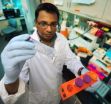(Press-News.org) AUGUSTA, Ga. – Connecting the dots between two molecules whose levels are decreased in depression and increased by current antidepressants could yield new therapies, researchers say.
Serotonin is a neurotransmitter that enables brain cells to communicate and brain-derived neurotropic factor, or BDNF, is a brain-nourishing molecule that also aids connectivity. Popular antidepressants such as Prozac, developed to increase levels of serotonin, have recently been found to also increase BDNF levels, said Dr. Anilkumar Pillai, neuroscientist at the Medical College of Georgia at Georgia Health Sciences University.
"We don't know how the molecule, serotonin, which is well-studied in depression, regulates BDNF signaling," Pillai said. He's principal investigator on a five year, $1.5 million grant from the National Institute of Mental Health to help him make the connection
He suspects a critical piece is the protein transglutaminase 2, or TG2, expressed by brain cells and most other cell types. TG2 plays a role in natural serotonin recycling and potentially is a factor in the serotonin deficiency associated with depression. It also may help explain why levels of serotonin and BDNF seem to rise and fall in sync, Pillai said.
TG2 coverts serotonin to Rac1, a protein that helps rejuvenate BDNF receptors, which typically sit on the surface of brain cells but must periodically move inside to reinvigorate. Depression appears to upset the balance of these complex, critical inner workings. Pillai hypothesizes that the high levels he has found in depression, likely result in too much serotonin conversion leaving too little of the neurotransmitter to properly support brain cell communication. Instead, more Rac1 is produced but – inexplicably – its degradation also increases ultimately decreasing BDNF signaling as well.
Pillai has seen the unfortunate chain of events play out in an animal model with increased levels of TG2 and clear signs of depression. "If you can fix problems with the receptor, you should be able to reverse depressive symptoms in these mice," he said
One of the many questions he wants to answer is whether existing antidepressants impact TG2. To help clarify the role of the impaired BDNF receptors, Pillai also wants to know whether giving BDNF to the depressed animal model improves depression. He's using a viral particle to directly activate the BDNF receptor. And he's also giving the TG2 inhibitor cysteamine to an animal model developed by administering stress hormones. He recently published in the journal PLoS ONE findings that the inhibitor appears effective in normalizing depressive behavior and BDNF levels in that model. Mental stress is a major factor in numerous psychiatric disorders including depression, schizophrenia and anxiety, he noted.
Some antidepressants, such as Prozac, were designed to interfere with a natural recycling of serotonin called reuptake so more serotonin is available where needed to enable cell communication. Pillai said it's not yet clear if serotonin reuptake is the same thing as its conversion to Rac-1.
"We need to learn more about how all these pieces fit to ultimately design new therapies for depression and related psychiatric disorders," he said. Dr. Alvin V. Terry Jr., MCG pharmacologist, is co-investigator on the studies.
Major depressive disorder is the leading cause of disability in Americans age 15-44, affects about 14.8 million adults and is more prevalent in women, according to the National Institute of Mental Health.
INFORMATION:
Studies seek better understanding and treatment of depression
2012-08-14
ELSE PRESS RELEASES FROM THIS DATE:
Can specialized HIV community pharmacies improve treatment?
2012-08-14
New Rochelle, NY, August 14, 2012—Community pharmacies with specially trained staff to provide HIV services can help HIV-infected individuals be more compliant with their essential antiviral drug regimens and hence improve patient outcomes. Users of HIV-specialized Walgreen pharmacies across the U.S. had significantly greater adherence to and persistence with their therapeutic drug regimens according to a study published in AIDS Patient Care and STDs, a peer-reviewed journal from Mary Ann Liebert, Inc., publishers. The article is available free on the AIDS Patient Care ...
Closing in on the border between primordial plasma and ordinary matter
2012-08-14
UPTON, NY - Scientists taking advantage of the versatility and new capabilities of the Relativistic Heavy Ion Collider (RHIC), an atom smasher at the U.S. Department of Energy's Brookhaven National Laboratory, have observed first glimpses of a possible boundary separating ordinary nuclear matter, composed of protons and neutrons, from the seething soup of their constituent quarks and gluons that permeated the early universe some 14 billion years ago. Though RHIC physicists have been creating and studying this primordial quark-gluon plasma (QGP) for some time, the latest ...
Impulsive micromanagers help plants to adapt, survive
2012-08-14
EAST LANSING, Mich. — Soil microbes are impulsive. So much so that they help plants face the challenges of a rapidly changing climate.
Jen Lau and Jay Lennon, Michigan State University biologists studied how plants and microbes work together to help plants survive the effects of global changes, such as increased atmospheric CO2 concentrations, warmer temperatures and altered precipitation patterns. The results, appearing in the current issue of the Proceedings of the National Academy of Sciences, showed that microbes in the ground not only interact with plants, but they ...
Scientists devise new strategy to destroy multiple myeloma
2012-08-14
Researchers at Virginia Commonwealth University Massey Cancer Center are reporting promising results from laboratory and animal experiments involving a new combination therapy for multiple myeloma, the second most common form of blood cancer.
The study published online in the journal Cancer Research details a dramatic increase in multiple myeloma cell death caused by a combination of the drugs obatoclax and flavopiridol. The researchers, led by Steven Grant, M.D., Shirley Carter Olsson and Sture Gordon Olsson Chair in Oncology Research, associate director for translational ...
Success of engineered tissue depends on where it's grown
2012-08-14
CAMBRIDGE, Mass. -- Tissue implants made of cells grown on a sponge-like scaffold have been shown in clinical trials to help heal arteries scarred by atherosclerosis and other vascular diseases. However, it has been unclear why some implants work better than others.
MIT researchers led by Elazer Edelman, the Thomas D. and Virginia W. Cabot Professor of Health Sciences and Technology, have now shown that implanted cells' therapeutic properties depend on their shape, which is determined by the type of scaffold on which they are grown. The work could allow scientists to ...
Hearing the telltale sounds of dangerous chemicals
2012-08-14
WASHINGTON, Aug. 14, 2012-- To warn of chemical attacks and help save lives, it's vital to quickly determine if even trace levels of potentially deadly chemicals—such as the nerve gas sarin and other odorless, colorless agents—are present. U.S. Army researchers have developed a new chemical sensor that can simultaneously identify a potentially limitless numbers of agents, in real time. A paper describing the system has been published today in the Optical Society's (OSA) journal, Optics Letters.
The new system is based on a phenomenon known as the photoacoustic effect, ...
New process doubles production of alternative fuel while slashing costs
2012-08-14
URBANA – A new discovery should make the alternative fuel butanol more attractive to the biofuel industry. University of Illinois scientist Hao Feng has found a way around the bottleneck that has frustrated producers in the past and could significantly reduce the cost of the energy involved in making it as well.
"The first challenge in butanol production is that at a certain concentration the fuel being created becomes toxic to the organism used to make it (Clostridium pasteurianum and other strains), and that toxicity limits the amount of fuel that can be made in one ...
Team discovers reason that male moths can keep finding females
2012-08-14
BOZEMAN, Mont. – A female moth sitting on a goal post could attract a male moth on the other end of a football field. And even if she switched her scent over time, the male could still find her because of a mutation to a single gene in his antenna.
A team of researchers led by Montana State University entomologist Kevin Wanner identified that gene after seeing how it adapted to even the slightest change in the chemicals female moths emit to attract males. The scientists explained their findings in the Aug. 13 online edition of the Proceedings of the National Academy of ...
New study finds the US wind power market riding a wave that is likely to crest in 2012
2012-08-14
Facing looming policy uncertainty beyond 2012, the U.S. remained one of the fastest-growing wind power markets in the world in 2011—second only to China—according to a new report released by the U.S. Department of Energy and prepared by Lawrence Berkeley National Laboratory (Berkeley Lab). Roughly 6.8 gigawatts (GW) of new wind power capacity were connected to the U.S. grid in 2011—more than the 5.2 GW built in 2010, but below the 10 GW added in 2009. Driven by the threat of expiring federal incentives, new wind power installations are widely expected to be substantially ...
Finding new research frontiers in a single cell
2012-08-14
Pioneering mass spectrometry methods developed at the U.S. Department of Energy's Ames Laboratory are helping plant biologists get their first glimpses of never-before-seen plant tissue structures.
The new method opens up new realms of study, ones that might have long-ranging implications for biofuels research and crop genetics.
"The data we're seeing are unprecedented," said Basil Nikolau, the Ames Laboratory faculty scientist heading up the project, funded by DOE's Office of Science.
The laboratory's team of researchers has developed a new more highly sensitive ...




